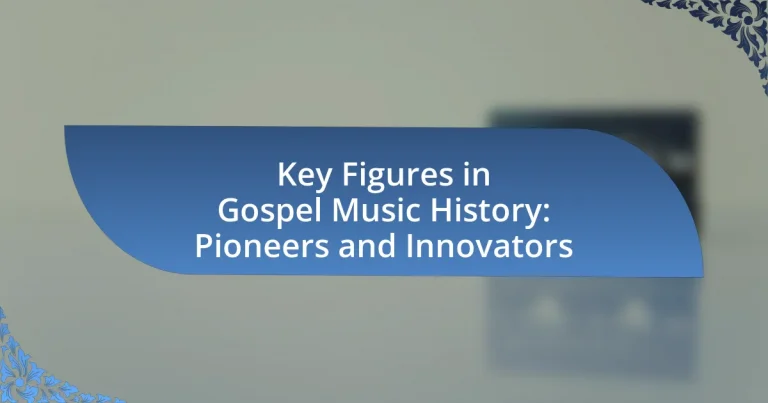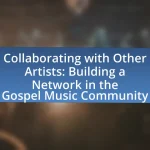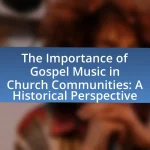The article focuses on key figures in gospel music history, highlighting pioneers and innovators such as Thomas A. Dorsey, Mahalia Jackson, and Andraé Crouch. It examines their contributions to the genre, including the blending of traditional hymns with blues and jazz, the popularization of gospel music in mainstream culture, and the evolution of contemporary styles. The article also discusses the role of church leaders, technological advancements, and the impact of social movements like the Civil Rights Movement on gospel music’s development. Additionally, it addresses the challenges faced by modern gospel artists and the importance of mentorship and collaboration in promoting the genre today.
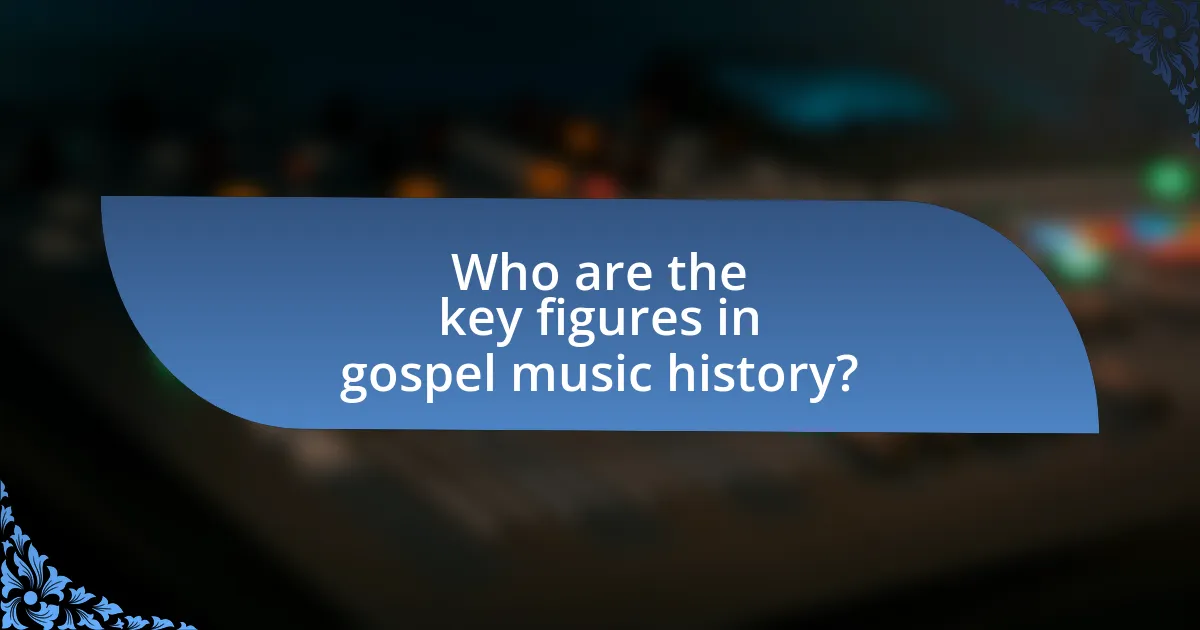
Who are the key figures in gospel music history?
Key figures in gospel music history include Thomas A. Dorsey, Mahalia Jackson, and Andraé Crouch. Thomas A. Dorsey, known as the “father of gospel music,” composed influential songs like “Take My Hand, Precious Lord,” which became an anthem during the Civil Rights Movement. Mahalia Jackson, a prominent gospel singer, brought the genre to mainstream audiences with her powerful voice and performances, significantly impacting the popularity of gospel music in the 20th century. Andraé Crouch, a pioneer in contemporary gospel, blended traditional gospel with modern musical styles, influencing a new generation of artists and expanding the genre’s reach. These figures played crucial roles in shaping gospel music’s evolution and cultural significance.
What roles did pioneers play in shaping gospel music?
Pioneers played a crucial role in shaping gospel music by introducing new musical styles, themes, and performance practices that influenced its development. Figures such as Thomas A. Dorsey, often referred to as the “father of gospel music,” blended blues and jazz elements with traditional hymns, creating a new genre that resonated with African American communities in the early 20th century. Additionally, pioneers like Mahalia Jackson popularized gospel music through powerful vocal performances and emotional delivery, bringing it to mainstream audiences. Their contributions established gospel music as a significant cultural and spiritual expression, leading to its recognition in various musical genres and its enduring legacy in American music history.
How did early gospel artists influence the genre’s development?
Early gospel artists significantly shaped the genre’s development by introducing a blend of spiritual themes and musical styles that resonated with diverse audiences. Pioneers like Thomas A. Dorsey, often referred to as the “father of gospel music,” fused blues and jazz elements with traditional hymns, creating a new sound that appealed to both churchgoers and secular listeners. This innovative approach not only expanded the reach of gospel music but also laid the groundwork for future artists to explore various musical influences, leading to the genre’s evolution into contemporary forms. The impact of these early artists is evident in the widespread adoption of gospel music in various cultural contexts, influencing genres such as soul and R&B.
What contributions did church leaders make to gospel music?
Church leaders significantly shaped gospel music by integrating spiritual themes and biblical teachings into musical compositions. They established the foundation for gospel music through the creation of hymns and spirituals that conveyed messages of faith, hope, and redemption. Notably, figures such as Thomas A. Dorsey, often referred to as the “father of gospel music,” were influenced by church leaders who encouraged the blending of traditional hymns with blues and jazz elements, thus expanding the genre’s reach and appeal. Additionally, church leaders played a crucial role in organizing choirs and musical groups, fostering community engagement and participation in worship through music. Their leadership and vision were instrumental in the evolution of gospel music as a vital expression of African American culture and spirituality.
What innovations have transformed gospel music over the years?
Innovations that have transformed gospel music over the years include the incorporation of contemporary musical styles, advancements in recording technology, and the rise of digital distribution platforms. The blending of genres such as R&B, hip-hop, and pop with traditional gospel elements has broadened its appeal, as seen in artists like Kirk Franklin and Mary Mary, who have successfully fused these styles. Additionally, the development of multi-track recording and digital audio workstations has allowed for more complex arrangements and higher production quality, enabling artists to create richer soundscapes. The emergence of streaming services and social media has also revolutionized how gospel music is distributed and consumed, allowing for greater accessibility and reach, exemplified by the viral success of songs like “Take Me to Church” by Hozier, which, while not strictly gospel, reflects the genre’s influence in popular music.
How did technological advancements impact gospel music production?
Technological advancements significantly transformed gospel music production by introducing new recording techniques and equipment that enhanced sound quality and accessibility. Innovations such as multi-track recording, digital audio workstations, and synthesizers allowed gospel artists to experiment with diverse sounds and arrangements, leading to richer and more complex musical compositions. For instance, the introduction of the compact disc in the 1980s improved audio fidelity, making gospel music more appealing to a broader audience. Additionally, the rise of the internet and digital distribution platforms has enabled independent gospel artists to reach global audiences without the need for traditional record labels, thereby democratizing the production and distribution process.
What new styles emerged from traditional gospel music?
New styles that emerged from traditional gospel music include contemporary Christian music, urban gospel, and gospel hip-hop. Contemporary Christian music evolved in the late 20th century, incorporating pop and rock elements while maintaining spiritual themes. Urban gospel, which gained popularity in the 1990s, blends traditional gospel with R&B and hip-hop influences, appealing to a younger audience. Gospel hip-hop, a further evolution, combines rap with gospel lyrics, exemplified by artists like Lecrae and Kirk Franklin, who have successfully bridged the gap between genres while retaining the core messages of faith and hope.
Why is it important to recognize these figures in gospel music?
Recognizing key figures in gospel music is important because they have significantly shaped the genre’s development and cultural impact. These pioneers and innovators, such as Thomas A. Dorsey and Mahalia Jackson, introduced new musical styles and lyrical themes that resonate with spiritual and social issues. Their contributions not only enriched the musical landscape but also provided a voice for marginalized communities, influencing civil rights movements and fostering a sense of identity and belonging. Acknowledging their work ensures that their legacies are preserved and appreciated, highlighting the historical context and evolution of gospel music as a vital part of American cultural heritage.
How do their legacies continue to influence contemporary artists?
The legacies of key figures in gospel music history continue to influence contemporary artists by shaping the genre’s musical styles, themes, and cultural significance. For instance, artists like Mahalia Jackson and Thomas A. Dorsey established foundational elements such as emotional expression and spiritual storytelling, which contemporary gospel musicians still incorporate into their work. Additionally, the integration of gospel elements into various music genres, including R&B and hip-hop, demonstrates the lasting impact of these pioneers. Research shows that gospel music’s themes of hope and resilience resonate with modern audiences, further solidifying its relevance in today’s music landscape.
What lessons can modern musicians learn from these pioneers?
Modern musicians can learn the importance of innovation and authenticity from gospel music pioneers. These early artists, such as Thomas A. Dorsey and Mahalia Jackson, blended traditional spirituals with contemporary styles, demonstrating that musical evolution is essential for relevance. Their commitment to genuine expression and emotional connection with audiences highlights the value of authenticity in artistry. For instance, Dorsey’s integration of blues elements into gospel music not only expanded the genre but also resonated deeply with listeners, proving that embracing one’s unique influences can lead to greater artistic impact.
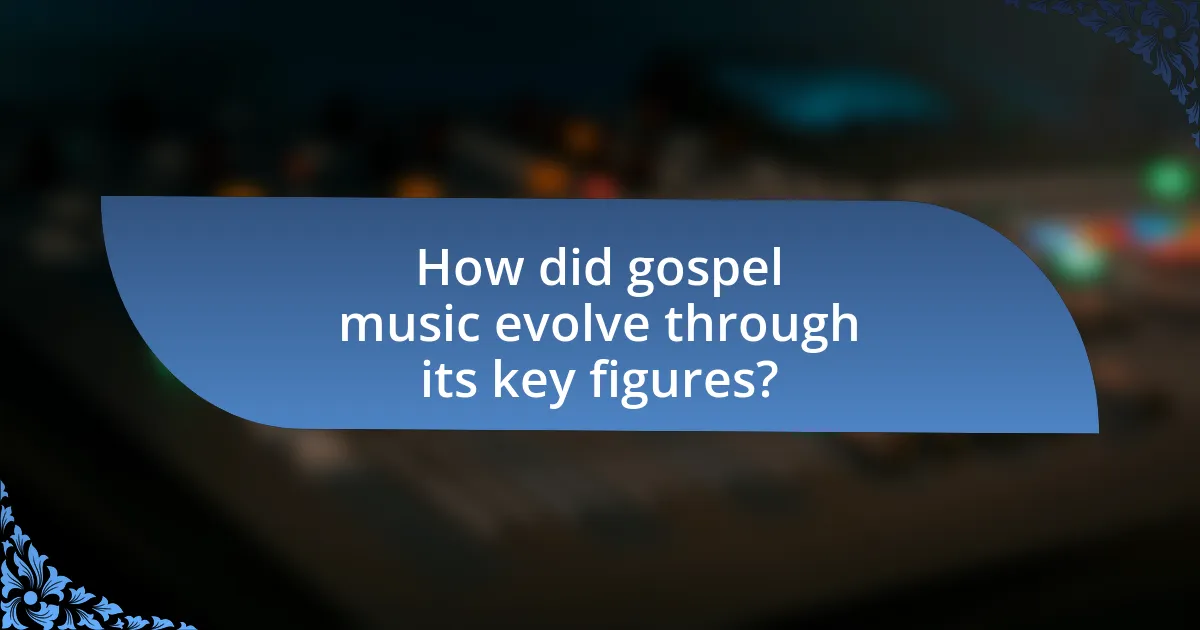
How did gospel music evolve through its key figures?
Gospel music evolved significantly through key figures who shaped its sound and direction. Pioneers like Thomas A. Dorsey, often referred to as the “father of gospel music,” integrated blues and jazz elements into traditional hymns, creating a new genre that resonated with African American communities in the early 20th century. His composition “Take My Hand, Precious Lord” became an anthem during the Civil Rights Movement, illustrating the genre’s role in social change.
Additionally, Mahalia Jackson, known for her powerful voice, popularized gospel music on a national scale, bringing it to mainstream audiences and influencing artists across genres. Her performances emphasized emotional expression and spiritual depth, further solidifying gospel’s place in American music.
Moreover, figures like Andraé Crouch introduced contemporary styles in the 1960s and 1970s, blending gospel with pop and rock influences, which expanded its appeal to younger generations. This evolution reflects the adaptability of gospel music, as it continues to incorporate diverse musical elements while maintaining its core message of faith and hope.
What were the major movements in gospel music history?
The major movements in gospel music history include the African American spirituals, the rise of gospel quartets in the early 20th century, the development of urban gospel in the 1930s, the emergence of contemporary gospel in the late 20th century, and the incorporation of gospel into popular music genres. African American spirituals, originating from the 18th and 19th centuries, laid the foundation for gospel music, expressing the struggles and hopes of enslaved people. The gospel quartet movement, characterized by groups like the Golden Gate Quartet, gained popularity in the 1920s and 1930s, emphasizing harmony and vocal arrangements. Urban gospel, which emerged in cities, blended traditional gospel with jazz and blues influences, exemplified by artists like Mahalia Jackson. The late 20th century saw the rise of contemporary gospel, integrating modern musical styles and reaching broader audiences, with artists such as Kirk Franklin leading this movement. These movements collectively shaped the evolution of gospel music, reflecting cultural and social changes within the African American community.
How did the Civil Rights Movement influence gospel music?
The Civil Rights Movement significantly influenced gospel music by integrating themes of social justice, empowerment, and resistance into its lyrics and performances. Artists like Mahalia Jackson and Sam Cooke used gospel music as a platform to express the struggles and aspirations of African Americans during this period, with songs such as “We Shall Overcome” becoming anthems for the movement. The movement’s emphasis on community and collective action resonated within gospel music, leading to a fusion of spiritual and political messages that galvanized audiences and inspired activism. This connection between gospel music and the Civil Rights Movement is evidenced by the way churches became centers for organizing protests and rallies, further solidifying gospel music’s role in advocating for civil rights.
What role did the Black church play in the evolution of gospel music?
The Black church was instrumental in the evolution of gospel music by serving as its primary birthplace and nurturing ground. This religious institution provided a space for the development of spirituals, hymns, and later, gospel songs that expressed the struggles and hopes of the African American community. The incorporation of call-and-response patterns, emotional expression, and improvisation in worship services significantly shaped the musical style of gospel music. Historical evidence shows that figures like Thomas A. Dorsey, often referred to as the “father of gospel music,” emerged from the Black church, where he blended traditional hymns with blues elements, further evolving the genre. The Black church not only fostered the creation of gospel music but also played a crucial role in its dissemination, as congregations spread these musical forms throughout the United States, influencing various music genres and cultural movements.
Who are some of the most influential gospel artists of the 20th century?
Some of the most influential gospel artists of the 20th century include Mahalia Jackson, Thomas A. Dorsey, and Aretha Franklin. Mahalia Jackson, known as the “Queen of Gospel,” popularized gospel music with her powerful voice and emotional delivery, significantly impacting the genre’s reach. Thomas A. Dorsey, often referred to as the “Father of Gospel Music,” composed many classic gospel songs and helped establish gospel as a respected musical form. Aretha Franklin, while primarily known as a soul artist, infused gospel elements into her music, showcasing the genre’s influence on popular music and earning acclaim for her gospel recordings.
What impact did Mahalia Jackson have on gospel music?
Mahalia Jackson significantly shaped gospel music by popularizing the genre and bringing it to mainstream audiences. Her powerful contralto voice and emotive singing style helped elevate gospel music’s status, making it a vital part of American music culture. Jackson’s performances, particularly at the Newport Jazz Festival in 1956 and her collaboration with influential artists, showcased gospel music’s emotional depth and spiritual significance, influencing countless musicians across various genres. Her recordings, such as “Move On Up a Little Higher,” became best-sellers, demonstrating the commercial viability of gospel music and inspiring future generations of artists.
How did Thomas A. Dorsey change the landscape of gospel music?
Thomas A. Dorsey revolutionized gospel music by blending traditional hymns with blues and jazz elements, creating a new genre known as gospel blues. His composition “Take My Hand, Precious Lord,” written in 1932, became a cornerstone of gospel music and showcased this innovative fusion. Dorsey’s work not only popularized gospel music in African American churches but also laid the foundation for future artists, influencing the sound and structure of contemporary gospel music. His contributions established gospel as a distinct musical form, recognized for its emotional depth and spiritual significance.
What are the defining characteristics of gospel music?
Gospel music is characterized by its spiritual themes, strong vocal emphasis, and incorporation of various musical styles, including blues, jazz, and hymns. The lyrics often focus on faith, worship, and personal testimony, reflecting the Christian experience. Historically, gospel music emerged from African American religious traditions in the early 20th century, with roots in spirituals and hymns. Notable figures such as Thomas A. Dorsey, known as the “father of gospel music,” played a crucial role in shaping its sound and structure, blending traditional church music with contemporary elements. This fusion has led to the development of sub-genres like contemporary gospel and urban gospel, further defining the genre’s evolution and appeal.
How do lyrics and themes reflect the cultural context of gospel music?
Lyrics and themes in gospel music reflect the cultural context by addressing social issues, spiritual struggles, and communal experiences of African American communities. The origins of gospel music are deeply rooted in the African American experience, particularly during the periods of slavery and the Civil Rights Movement, where songs served as both a form of worship and a means of expressing hope and resilience. For instance, songs like “We Shall Overcome” became anthems for civil rights, illustrating how gospel music encapsulated the fight for justice and equality. Additionally, the use of call-and-response patterns in gospel music mirrors African musical traditions, reinforcing community and collective identity. This cultural interplay highlights how gospel music not only serves a religious purpose but also acts as a historical narrative of the African American struggle and triumph.
What musical elements are unique to gospel music compared to other genres?
Gospel music is characterized by its unique use of call-and-response patterns, rich harmonies, and emotional vocal delivery. These elements distinguish it from other genres, as the call-and-response technique fosters communal participation, often seen in church settings. Additionally, gospel music frequently employs syncopated rhythms and a strong emphasis on the backbeat, which enhances its energetic and uplifting nature. The use of improvisation in vocal performances further sets gospel apart, allowing singers to express personal spirituality and emotion. Historical context supports these distinctions, as gospel music evolved from African American spirituals and church hymns, integrating elements from blues and jazz while maintaining its distinct identity.
What are the contemporary implications of gospel music’s history?
The contemporary implications of gospel music’s history include its influence on various music genres, social movements, and cultural identity. Gospel music has shaped the development of genres such as soul, R&B, and hip-hop, with artists like Aretha Franklin and Kanye West drawing from its rich traditions. Additionally, the historical context of gospel music, rooted in African American spirituals and the civil rights movement, continues to inspire activism and community solidarity today. For instance, gospel choirs often participate in social justice initiatives, reflecting the genre’s enduring role in advocating for equality and empowerment. This historical legacy underscores the ongoing relevance of gospel music in addressing contemporary social issues and fostering cultural connections.
How do modern gospel artists pay homage to their predecessors?
Modern gospel artists pay homage to their predecessors by incorporating traditional elements, styles, and themes into their music. For instance, many contemporary gospel songs feature classic chord progressions and vocal techniques that were popularized by early gospel pioneers like Mahalia Jackson and Thomas A. Dorsey. Additionally, artists often reference or cover songs from these influential figures, ensuring that their contributions remain recognized and celebrated. Collaborations between modern artists and veterans of the genre also serve to bridge generational gaps, allowing for a direct connection to the roots of gospel music. This practice not only honors the legacy of earlier musicians but also educates new audiences about the historical significance of gospel music.
What are some examples of contemporary gospel music that reflect traditional influences?
Contemporary gospel music that reflects traditional influences includes artists and songs such as Kirk Franklin’s “Stomp,” which incorporates elements of traditional gospel with modern hip-hop beats, and Tasha Cobbs Leonard’s “Break Every Chain,” which draws on classic gospel themes of deliverance and faith. Additionally, the song “Take Me to the King” by Tamela Mann showcases traditional gospel’s emotional depth while utilizing contemporary musical arrangements. These examples illustrate how contemporary gospel artists blend traditional gospel roots with modern styles, maintaining the genre’s spiritual essence while appealing to a broader audience.
How do collaborations between gospel and secular artists shape the genre today?
Collaborations between gospel and secular artists significantly shape the genre today by broadening its appeal and fostering cross-genre innovation. These partnerships often result in the blending of musical styles, which attracts diverse audiences and introduces gospel themes to listeners who may not typically engage with the genre. For instance, artists like Chance the Rapper have incorporated gospel elements into mainstream hip-hop, exemplifying how such collaborations can elevate gospel music’s visibility and relevance in contemporary culture. This fusion not only revitalizes traditional gospel sounds but also encourages a new generation of artists to explore spiritual themes within various musical contexts, thereby expanding the genre’s reach and influence.
What challenges do gospel musicians face in the current music industry?
Gospel musicians face significant challenges in the current music industry, including market saturation, financial instability, and limited access to mainstream platforms. The rise of digital streaming has intensified competition, making it difficult for gospel artists to stand out among numerous genres. Financially, many gospel musicians struggle with inconsistent income due to reliance on live performances and donations, which can fluctuate greatly. Additionally, mainstream media often overlooks gospel music, limiting exposure and opportunities for collaboration with other artists. These factors collectively hinder the growth and sustainability of gospel musicians in a rapidly evolving industry.
How can gospel artists navigate the balance between tradition and innovation?
Gospel artists can navigate the balance between tradition and innovation by integrating contemporary musical elements while honoring the foundational aspects of gospel music. This approach allows artists to reach broader audiences without losing the genre’s spiritual essence. For instance, artists like Kirk Franklin have successfully blended traditional gospel with hip-hop and R&B, creating a fresh sound that resonates with younger generations while maintaining core gospel themes. This strategy not only preserves the genre’s heritage but also encourages its evolution, as evidenced by the increasing popularity of gospel-infused genres in mainstream music charts.
What strategies can gospel musicians use to reach wider audiences?
Gospel musicians can reach wider audiences by leveraging digital platforms and social media for promotion. Utilizing platforms like YouTube, Spotify, and Instagram allows artists to share their music and connect with fans globally. For instance, a study by the International Federation of the Phonographic Industry (IFPI) in 2021 indicated that 70% of music listeners discover new music through streaming services and social media. Additionally, collaborating with artists from different genres can introduce gospel music to diverse audiences, as seen with artists like Kirk Franklin, who has successfully blended gospel with hip-hop and R&B, expanding his reach significantly. Engaging in live performances, both in-person and virtual, also enhances visibility, as live events often attract new listeners and create community connections.
What resources are available for aspiring gospel musicians?
Aspiring gospel musicians can access various resources, including online courses, music workshops, and mentorship programs. Online platforms like Coursera and Udemy offer courses specifically tailored to gospel music, covering topics such as vocal techniques and songwriting. Additionally, organizations like the Gospel Music Association provide workshops and networking opportunities that connect musicians with industry professionals. Furthermore, local churches often host music programs and events that allow aspiring musicians to gain experience and exposure. These resources collectively support the development of skills and connections essential for success in the gospel music industry.
How can mentorship from established artists benefit newcomers in gospel music?
Mentorship from established artists significantly benefits newcomers in gospel music by providing guidance, industry insights, and networking opportunities. Established artists can share their experiences, helping newcomers navigate the complexities of the music industry, including songwriting, performance techniques, and marketing strategies. For instance, artists like Kirk Franklin and CeCe Winans have openly discussed their mentorship roles, emphasizing how sharing knowledge can accelerate the growth of emerging talents. This transfer of wisdom not only enhances the newcomers’ skills but also increases their visibility through established networks, ultimately fostering a more robust gospel music community.
What are the best practices for promoting gospel music in today’s market?
The best practices for promoting gospel music in today’s market include leveraging social media platforms, engaging with local communities, and collaborating with influencers. Social media platforms like Instagram, Facebook, and TikTok allow artists to reach a wider audience and share their music directly with fans. Engaging with local communities through live performances and church events fosters a personal connection and builds a loyal fan base. Collaborating with influencers who resonate with gospel music can amplify reach and credibility, as seen with artists like Kirk Franklin, who effectively use these strategies to enhance their visibility and impact in the music industry.
